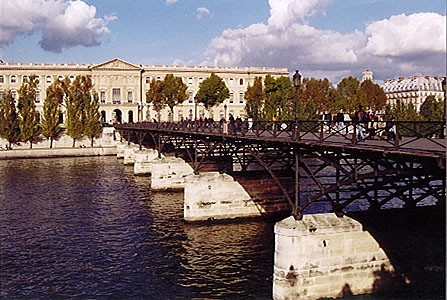By a decree of 15th March 1801, Bonaparte ordered the construction of
a bridge which would connect the Louvre and the Collège des
Quatre-Nations, the present day Institut de France. And this work marks the
introduction of a new building material, iron. An attempt had been
made in Lyons but it was in Paris that the first ever French iron bridge
was built. And it was the third of its kind in the world, after the
ironbridges of Coalbrookdale and Sunderdale in England. Indeed it
was the First Consul who presided over the choice of the material,
depite the reticence of the two most famous architects of the period,
Fontaine and Percier. And they expressed their doubts in a letter to
Bourienne. Whilst recognising the need for such a construction in
such a spot, they took issue with completely unaesthetic qualities of
the ensemble: 'The city will gain little from the building of an iron
bridge. Such a bridge will of necessity be very narrow and it will
diminish this beautiful stretch of water, often used for fêtes. Nor will
it, with its light structure, match the magnificence of the two
monuments between which it will be built'. Bonaparte consequently
went elsewhere and gave the project to the engineer Louis-Alexandre
de Cessart. The plans were subsequently changed by Jacques Dillon
who changed the material from iron to pig iron. The bridge was begun
in August 1801 and opened 1st Vendémiaire Year XII (24 November
1803). Since in those days the Louvre had been renamed the Palais
des Arts (Palace of the Arts), the bridge was christened the 'Pont de
Arts'.
As a simple footbridge crossing between the right and left banks of the
Seine, the bridge was raised above the ground level of the two banks
and comprised wooden planking resting on nine arches each of a span
of 18.5 metres supported by masonry piles. And despite the fact that,
as with most bridges of the period, all users had to pay a toll, the
bridge was almost immediately adopted by Parisians. On the first day
alone people are reported to have made 64,000 crossings, and this was
to settle down to a daily 11,000 crossings. And very quickly the pont
des Arts became a popular place to promenade. An ice-cream
salesman appeared, as did a florist who place orange trees and rare
shrubs along the iron balustrades of the bridge, whilst the benches
became welcome resting places and lanterns provided light in the
evenings. Some gossip colunmists affirmed that amorous assignations.
However, despite the fact that the bridge went straight to Parisian's
hearts, the effect on the First Consul was quite the opposite. He
deplored the metal structure's lack of monumentality: 'It has no
feeling of solidity about it; it has no grandeur. I can understand that in
England where stone is rare they use iron for arches of enormous
dimensions; but in France where everything abounds… As for the
bridge's solidity, Napoleon was right – but only 160 years later! The
bridge was closed to the public in 1970 because the structure was
deemed too fragile and also because it had been damaged by some
passing barges. Rebuilt in 1984 on similar plans, but this time in steel,
the bridge today only has seven arches which rest on six masonry
piles. But the wooden planks, the benches and the shrubs all recall the
charm of the original bridge, which since its construction has
remained one of the capital's most attractive monuments.
Pont des Arts Bridge


